Ibaraki and more
- Sort by
- Popularity
- Name
-
Koshu lacquered deer leather Koshu inden
- Other crafts
- Yamanashi
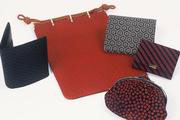
Koshu lacquered deer leather (called Koshu inden in Japanese) is a unique style of leathercraft that was developed in the city of Kofu, Yamanashi prefecture. Koshu lacquered deer leather is unique because of its combination of deer leather and uru…
View more
-
Mino ware Mino yaki
- Ceramic
- Gifu
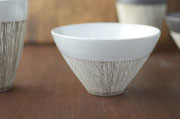
Mino ware (called Mino yaki in Japanese) is a ceramic ware produced in the Tono area of Gifu prefecture. It has a long history and tradition but has adapted to modern life style. A notable feature of Mino ware is its wide variety of pottery. Mino …
View more
-
Yuki tsumugi silk Yuki tsumugi
- Woven textiles
- Ibaraki

Yuki tsumugi silk is produced principally in the reaches of the Kinugawa River that straddles the Ibaraki and Tochigi prefectures. The Japanese name Yuki tsumugi comes from the name of a feudal lord during the Kamakura period (1185-1333), Yuki. Al…
View more
-
Kasama ware Kasama yaki
- Ceramic
- Ibaraki

Kasama ware (called Kasami yaki in Japanese) is a form of porcelain produced in the area around the city of Kasama in Ibaraki prefecture. This porcelain has long been considered a traditional souvenir of visiting Kasama Inari shrine (one of Japan&…
View more
-
Mino traditional Japanese paper Mino washi
- Traditional Japanese paper
- Gifu
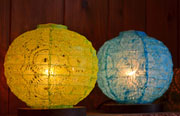
Mino washi is a type of Japanese paper made in Gifu prefecture. Washi is made from paper mulberry which is a plant that grows in the city of Mino, a place of abundant forests. Ancient manuscripts in the Shosoin Repository* indicate the history of …
View more
-
Satsuma ware Satsuma yaki
- Ceramic
- Kagoshima
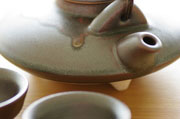
Satsuma ware (called satsuma yaki in Japanese) is a form of porcelain produced in Kagoshima prefecture. There are three types of Satsuma ware: white, black, and porcelain. Then there are six categories: tateno, ryumonji, naeshirogawa, nishimochida…
View more
-
Kiso lacquerware Kiso shikki
- Lacquerware
- Nagano
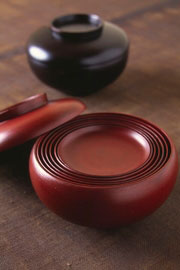
Kiso lacquerware (called Kiso shikki in Japanese) is produced in Kiso district, now the city of Shiojiri, Nagano prefecture. The area where this craft is produced is a plateau approximately 900 meters above sea level. The climate has cool summers…
View more
-
Matsumoto furniture Matsumoto kagu
- Wood, bamboo crafts
- Nagano

Matsumoto kagu is a type of Japanese traditional furniture made in the city of Matsumoto in Nagano prefecture and has been produced for over three hundred years, since the Edo period (1603-1868). The Second World War led production of this craft t…
View more
-
Gifu lanterns Gifu chochin
- Other crafts
- Gifu
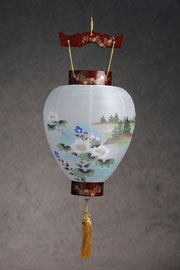
Gifu lanterns (called Gifu chochin in Japanese) are produced in the city of Gifu, Gifu prefecture and have a history of over three hundred years. In 1995, their high level of craftsmanship was recognized with a designation as a National Traditiona…
View more
-
Sekishu traditional Japanese paper Sekishu washi
- Traditional Japanese paper
- Shimane
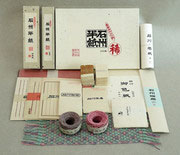
Sekishu washi is a traditional Japanese paper produced in the Iwami region of Shimane prefecture. As an ancient craft, it has a history of around 1300 years. The name Sekishu is found in writings from the Heian period (794-1185). There is also a s…
View more
-
Ichii woodcarvings Ichii itto bori
- Wood, bamboo crafts
- Gifu

Ichii woodcarvings (called Ichii itto bori in Japanese) are produced in the Hida region of Gifu prefecture, and made only from the wood of ichii (Japanese yew), the prefectural tree of Gifu. The ichii tree gets its name from a scepter made of Japa…
View more
-
Unshu abacus Unshu soroban
- Writing tools
- Shimane
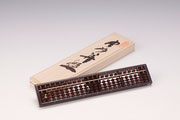
Unshu abacuses (called Unshu soroban in Japanese) are produced in the town of Okuizumo, Shimane prefecture. Japanese abacuses are traditional tools that use columns lined with beads that are quickly moved with the fingers to do calculations. They …
View more
-
Hida-shunkei lacquerware Hida shunkei
- Lacquerware
- Gifu
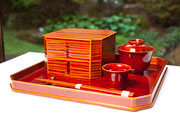
Hida-shunkei lacquerware is produced around the city of Takayama in Gifu prefecture. The name is said to come from the fact that the articles produced initially had a similar coloring to Hishunkei tea containers. This craft is notable for having …
View more
-
Honba oshima tsumugi silk Honba oshima tsumugi
- Woven textiles
- Kagoshima
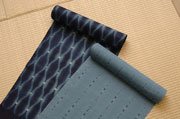
Honba Oshima Tsumugi is a fabric made on the island of Amami, Kagoshima prefecture. It is one hundred percent plain silk that has been dyed and made on handlooms like shime-bata or te-bata. This textile has deep, muted tones as it is dyed with ye…
View more
-
Iwami ware Iwami yaki
- Ceramic
- Shimane
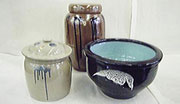
Iwami ware (called Iwami yaki) is a type of pottery produced around the city of Gotsu, Shimane prefecture. Iwami ware is strong, has low water absorbency and is resistant to salt, acid, and alkali which makes it suitable for storing pickled plums …
View more
-
Shinshu tsumugi silk Shinshu tsumugi
- Woven textiles
- Nagano
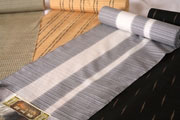
Shinshu tsumugi is a type of silk fabric also known as pongee and produced throughout Nagano prefecture. Each region in the prefecture has their own production styles and techniques. Also, the specific name of this fabric differs depending on the …
View more
-
Iiyama Buddhist altar Iiyama butsudan
- Household Buddhist altars
- Nagano
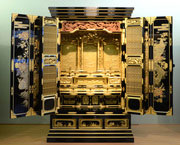
Iiyama Buddhist Altars, called Iiyama Butsudan in Japanese, are made around the city of Iiyama, Nagano prefecture. Iiyama is known for its people being devout to Buddhism since ancient times, which sustains the tradition of altar production. This …
View more
-
Kawanabe Buddhist altar Kawanabe butsudan
- Household Buddhist altars
- Kagoshima
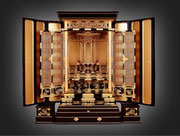
Kawanabe Buddhist Altars (called Kawanabe Butsudan in Japanese) are made in the Kawanabe area of Minamikyushu, Kagoshima prefecture. There is a specific type of altar called gamado that is unique to this craft. Gama means cave in the Kagoshima dia…
View more
-
Nibutani carved wooden tray Nibutani ita
- Wood, bamboo crafts
- Hokkaido
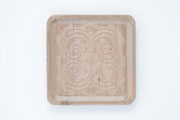
Nibutani Carved Wooden Trays (called Nibutani ita in Japanese) are produced in Biratori, Hokkaido. The origin of the town name, is an Ainu language word for cliff, pirauturu. This craft is known for its patterns like a spiral pattern called moreun…
View more
-
Uchiyama Japanese paper Uchiyama gami
- Traditional Japanese paper
- Nagano
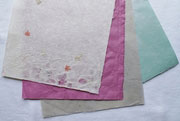
Uchiyama Gami is a type of traditional Japanese paper made in the Oku-shinano region of northern Nagano prefecture. As a region that gets heavy snowfall during the winter, papermaking production developed to provide supplementary income. This craf…
View more
-
Koshu crystal and precious stones carving Koshu suisho kiseki zaiku
- Semiprecious stone craftwork
- Yamanashi
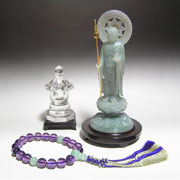
Koshu crystal and precious stones carving called Koshu Suisho Kiseki zaiku in Japanese, are crystal and precious gemstone carvings produced in the city of Kofu, Yamanashi prefecture. Using traditional methods, natural gemstones are carefully cut, …
View more
-
Nibutani bark cloth Nibutani attoushi
- Woven textiles
- Hokkaido
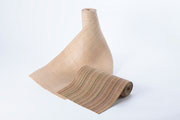
Nibutani Bark Cloth (called Nibutani-attushi in Japanese) is a bark fiber fabric produced in the region surrounding the the town of Biratori, Hokkaido. The term Nibutani originates from niputai which is an Ainu (indigenous people of north Japan) l…
View more
-
Shinshu Forged Blades Shinshu uchihamono
- Metal works
- Nagano
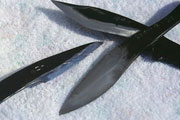
Shinshu Forged Blades or Shinshu Uchihamono in Japanese, are metalworks produced around Nagano, Nagano prefecture. As this area was formerly a province called Shinano which was also called Shinshu, these blades are known under the name of "Sh…
View more
-
Nagiso woodturning Nagiso rokuro zaiku
- Wood, bamboo crafts
- Nagano
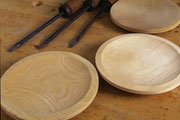
Nagiso Rokuro Zaiku are completely handmade woodwork items made in the area around Nagiso Town, Kiso-gun, Nagano Prefecture. This traditional craft originated in the first half of the 18th century and is known for a special skilled manufacturing c…
View more
-
Makabe stone lanterns Makabe ishidoro
- Stonework
- Ibaraki
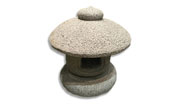
Makabe Ishitoro is the Japanese name for Makabe stone lanterns produced around the town of Makabe in the Ibaraki Prefecture. Production of this traditional craftwork started during the Kamakura period (1185-1333). The stone industry in the Makabe …
View more
-
Koshu hand-carved seals Koshu tebori insho
- Other crafts
- Yamanashi
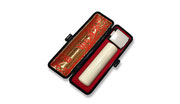
Koshu Tebori Insho are hand-engraved personal signature stamps produced in Kofu City and Fujiyoshida City of Yamanashi Prefecture. Bringing together all of Yamanashi’s engravers, dealers, and material producers, this local industry is unlike those…
View more
-
Izumo stone lanterns Izumo ishidoro
- Stonework
- Shimane
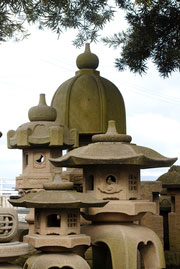
Izumo stone lanterns are stone lanterns produced in the city of Sakai Minato in the Tottori prefecture, and in the cities of Matsue and Izumo in the Shimane prefecture. They are made of Kimachi stone, fine-grained tuffaceous sandstone quarried fro…
View more
-
Gifu Japanese Umbrellas Gifu Wagasa
- Other crafts
- Gifu
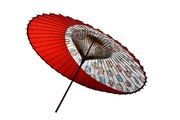
Japanese umbrellas are not only used on rainy days or as parasols, but there are also umbrellas used for dancing and larger parasols called nodategasa used for outdoor tea ceremonies. They become very slim and delicate when they are closed, and t…
View more
- 1

































































































































































































































































































